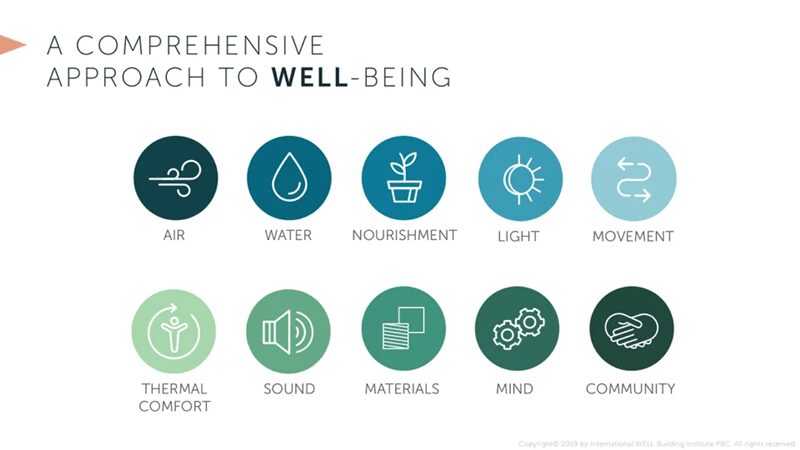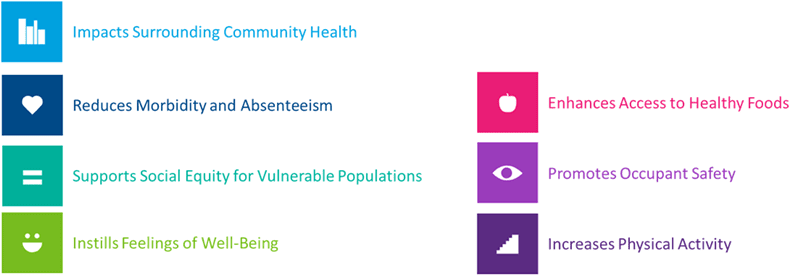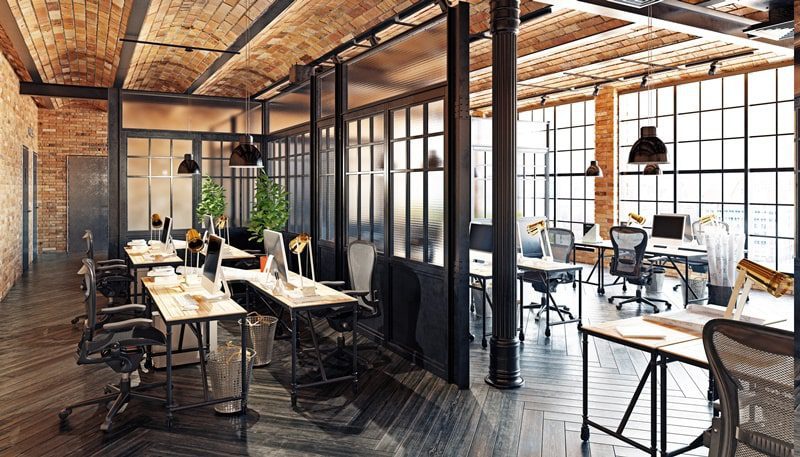Introduction to Healthy Building Certifications
Even before COVID-19 and mandated social distancing, humans were spending an incredible amount of time indoors—roughly 90% of our time, in fact. All this time spent indoors has a tremendous impact on our health and wellness, but now, more than ever the quality of our building environments matters as concerns over limiting the spread of infectious diseases and maintaining air quality have prompted a closer look at the buildings in which we live, work, and operate.
According to the EPA, there is strong qualitative and quantitative evidence demonstrating the relationship between indoor air quality (IAQ) and human productivity and performance. By improving air quality in buildings, studies have shown an improved mental ability when it comes to tasks such as concentration and recall in both adults and children—an increase of as much as 8-11% in terms of productivity improvements according to the World Green Building Council. Indeed, air quality is so crucial to the development of healthy buildings that the Center for Climate, Health, and the Global Environment at Harvard’s School of Public Health included it as one of its nine foundations for healthy buildings.

To support the development of healthier building environments, groups have come together to develop a variety of healthy building certifications and standards to assist building owners and managers, such as LEED IAQ, WELL, Fitwel, RESET and others. These building certifications and standards provide a roadmap to achieving health, wellness, and sustainability goals for various building types. By pursuing these healthy building certifications and other wellness improvements, building owners and operators can grow the momentum of the healthy building movement and demonstrate that their buildings are safer and more comfortable than non-certified buildings.
With Class-A commercial real estate portfolios now being bench marked on performance criteria, not unlike those found in various healthy building certifications and standards, there is an impetus on facility enhancement and differentiation to improve building efficiency and health. While certification alone will not guarantee that occupants will avoid contracting or spreading disease, certifications do provide standards for environmental and air quality; two of the most impactful factors on transmission.
For example, some buildings may have inadequate ventilation, which may not have been designed or is not operated in a manner that provides sufficient outdoor air. As people typically have less control over their environments when they’re at work or school, this is likely to result in an increase in reported health problems over time if significant air pollution sources exist. By pursuing healthy building certifications such as LEED or RESET, both of which focus heavily on indoor air quality, building owners and managers can ensure they are actively monitoring and mitigating any air quality issues that arise.
But air quality is only one factor of many that contribute to healthier building environments and improved occupant comfort. There are many other complementary areas to focus on and even more healthy building certifications to explore.
An Overview of the Different Healthy Building Certifications
WELL
Created in 2014 by the Delos and the International WELL Building Institute (IWBI), the WELL Building Standard is one of the most popular certification programs with over 4,136 projects encompassing nearly 550 million square feet globally. WELL draws on scientific and medical research on environmental health and effects to advance how people live, work, and operate in the built environment. Like other certification programs such as LEED and PEER, WELL is administered by Green Business Certification Inc. (GBCI).
WELL takes a holistic approach toward building health and wellness that is centered on 10 core concepts:

Each of these core concepts is further broken down into 23 preconditions and 94 optimizations available to acquire the desired number of certification points. The “Thermal Comfort” concept, for instance, is centered around improving thermal comfort for occupants and requires one precondition (Thermal Performance) with six optimizations available to satisfy the requirement. Generally, building upgrades for this concept might include enhanced HVAC systems or advanced controls optimization.
As people start returning to their places of work or study, they will naturally have concerns about the cleanliness and healthiness of the buildings they occupy. WELL standards have the potential not only to mitigate these concerns through a demonstrated commitment to healthy building environments but also to deliver meaningful organizational benefits and an improved bottom line through increased workplace productivity and reduced absenteeism.
WELL tends to be a more complex process than the Fitwel certification, and even requires onsite performance testing by an approved WELL Assessor to ensure healthy building outcomes are being achieved. Projects are certified for three years, after which it must be re-certified. This offers an opportunity for ongoing improvements and higher certification levels.
In WELL v2, the rating systems have changed slightly to be more aligned with LEED certification, offering overlap in 36 areas. Projects are now able to earn up to 110 possible points with Silver (50-59 points), Gold (60-79 points), and Platinum (80+ points).
Fitwel
Created in 2017 in a joint effort by the Center for Active Design, the Center for Disease Control, and the U.S. General Services Administration, the Fitwel Rating System has quickly become a popular choice for building owners and managers looking to promote the health and wellness of their occupants. Fitwel is generally considered one of the least expensive and least complicated certification processes, assessing buildings on how well they follow a recommended list of 63 evidence-based design and policy strategies targeting building health and productivity.
Fitwel centers on the belief that buildings can be incrementally improved to create healthier building environments by following strategies linked to one of seven Fitwel Health Impact Categories:

Within these seven Health Impact Categories, the Fitwel scorecard is further broken down into 12 categories of recommended evidence-based health and wellness strategies, including Indoor Environment, focused on improving air quality through, limiting harmful air pollutants and reducing exposure to them.
Once a building has registered with Fitwel, it will receive an automatic benchmark to track over time. Similar to WELL, Fitwel has a points structure wherein earning more points through approved upgrades and improvements results in higher certification levels (1, 2, or 3-star ratings for Fitwel as opposed to Silver, Gold, and Platinum ratings for WELL). Points are awarded based on the health and wellness impact resulting from an improvement as well as and how much evidence there is to tie the strategy to improved well-being. A 3-star rating for Fitwel, the highest available, denotes a building is supporting the well-being of its occupants with an exemplary number of evidence-based health and wellness strategies
In order to be eligible for a Fitwel certification, a building must earn a minimum number of optional points (90 out of 144 possible), with no individual criteria or strategies being required to achieve certification. This adds to the flexibility of the Fitwel certification as it allows Fitwel users to choose a mixture of strategies that are best suited to their individual projects. For example, if air quality was a primary concern for a building seeking Fitwel certification, the building owners and operators might focus their efforts on the “Indoor Environment” strategy and make improvements to reduce harmful air pollutants and improve air quality accordingly.
In addition to its simplicity, Fitwel is also much cheaper than certifications like WELL, requiring a registration fee of only $500 compared with a starting WELL registration fee of between $1500-4200, at the time of this writing. Both programs have additional certification costs based on building square footage. For organizations that go the Fitwel route, discounts are available at scale through the Fitwel Champions program.
RESET
The RESET™ Air standard is a sensor-based and performance-driven indoor air quality standard developed for folks who want to improve occupant comfort and who take air quality seriously. Unlike WELL and other building certifications that may target indoor air quality, RESET is much more stringent in prioritizing occupant health, even requiring buildings to be re-certified annually.
There are two types of projects to which RESET certification can be applied: commercial interiors and core & shell.
- RESET Air – Commercial Interiors (CI) tracks and communicates the health performance of building interiors in new or existing project types (i.e., what is the quality of the air people are breathing).
- RESET Air – Core & Shell (CS) tracks and communicates the health performance of the entire building in new or existing project types (i.e., the quality of the air generated from the project’s HVAC system).
RESET requires continuous air quality monitoring to ensure a project is meeting RESET’s specified IAQ performance targets. At a minimum, this means using a grade A or B monitor that can effectively track, measure, and report on temperature and humidity, PM2.5, TVOC, CO2, and CO (in spaces where combustion is present). This data is then sent to the RESET Assessment Cloud, where it is compared against acceptable limits.

Unlike the IAQ testing requirements for LEED or WELL, daily averages from real-time monitors must stay within the acceptable IAQ performance targets for three consecutive months in order to be certified. Through continuous monitoring, building owners and managers can achieve greater insight into their systems and adjust behavior immediately.
RESET provides a tangible return on investment for building owners and managers, designed to be scalable and affordable. Projects do not need to follow a set path to certification, enabling a greater opportunity for place-based solutions and innovation in design. Through this flexibility, project and certification costs can be kept low while delivering impactful health and wellness results for occupants.
For customers who are interested in a sensor-based approach to Healthy Buildings, Veregy brings it deep expertise in building controls systems to ensure that RESET is the right fit for the customer and their operations.
LEED Indoor Air Quality (IAQ)
As discussed in our article, The Ultimate Guide to LEED Certification, the Leadership in Energy and Environmental Design™ (LEED®) certification is a third-party green building system developed and certified by the U.S. Green Building Council (USGBC).
Within LEED’s v4 Indoor Environmental Quality (IEQ) credit category, Indoor Air Quality uses the latest standards for testing ventilation. Testing is done to meet the minimum indoor air quality performance prerequisite, as well as the enhanced indoor air quality strategies credit. IEQ refers to the quality of a building’s environment as it relates to its occupant’s health and wellness (e.g., lighting, thermal comfort, acoustics, and air quality).
Although air quality only represents a portion of the listed requirements for LEED v4, minimum indoor air quality performance is a required measure and must be performed in order for a project to be LEED certified. In addition, many customers opt for the Enhanced Air Quality Strategies that include: the installation of an entryway system (mat or grille); the installation of MERV-13 filters; AND/OR the installation ofCO2 monitors; AND/OR the installation of airflow monitoring devices on outdoor air intake at equipment.
It is important to know, and take advantage of the fact, that there are significant overlaps between LEED and WELL, specifically in the area of indoor air quality. For example, LEED ventilation rates must meet the minimum standard of meeting ASHRAE 62.1-2010, while WELL requires the stricter 2013 version. Therefore, meeting WELL’s benchmark for ventilation means that your project has met the LEED standards as well. Another example is LEED’s optional Enhanced IAQ strategies credit for permanent entryway systems, where WELL requires the credit as a prerequisite for all projects, except interiors-only projects.
Lastly, Veregy assists customers in developing and implementing an indoor air quality management program based on EPA Indoor Air Quality Building Education and Assessment Model, with an audit conducted at least once every five years. This results in additional optional credits that are applied to the LEED project.
Selecting the Right Healthy Building Certification
Certifications and standards are complex. It’s no surprise that building owner confusion and inaction is the norm. Veregy’s team of knowledgeable healthy building specialists understands the complexities of certifications and standards. We work with our clients to unravel those complexities to reveal the best fit for their buildings and to develop simple pathways to achieving healthy building spaces for their occupants. We are looking forward to learning how we can help you on your path to certifying your Healthy Buildings.

